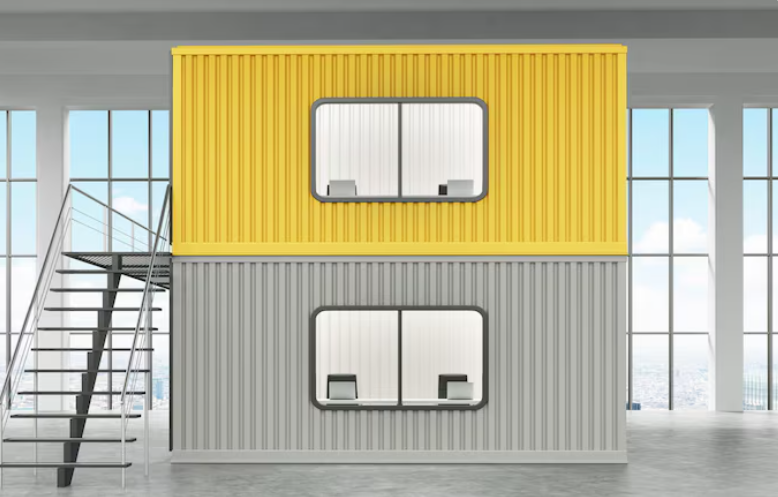Double story container homes are reshaping the residential landscape in the UAE, offering a sustainable, innovative, and adaptable housing solution that aligns with the nation’s vision for modernity and environmental stewardship. Constructed by stacking repurposed shipping containers to create multi-level dwellings, these homes combine durability, modularity, and aesthetic versatility. In a country known for its rapid urbanization, diverse population, and commitment to sustainable development, double story container homes address critical challenges like land scarcity, environmental impact, and the need for efficient construction methods. This guide provides an exhaustive exploration of these homes, delving into their design, construction, cultural relevance, sustainability, and future potential in the UAE.
The UAE’s unique context—blending cultural heritage with cutting-edge innovation—makes it an ideal setting for container homes. With cities like Dubai, Abu Dhabi, and Sharjah experiencing population growth and urban expansion, these homes offer a practical alternative to traditional construction, catering to families, professionals, and investors. Their ability to be customized for various lifestyles, from compact urban residences to spacious rural retreats, ensures broad appeal.
Understanding Double Story Container Homes
Double story container homes are residential structures formed by stacking two or more shipping containers vertically to create a multi-level living space. These homes leverage the inherent strength of shipping containers, typically made from 16-gauge corten steel, a corrosion-resistant material designed for maritime transport. Standard containers measure 20 feet (6 meters) or 40 feet (12 meters) in length, 8 feet (2.4 meters) in width, and 8.5 feet (2.6 meters) or 9.5 feet (2.9 meters) in height for high-cube models. High-cube containers are often preferred for residential use due to their additional headroom, enhancing comfort and design flexibility.
The construction process involves selecting containers that meet ISO standards for structural integrity, ensuring they are free from rust, dents, or chemical contamination. Containers are modified with precision, including cutting openings for windows, doors, skylights, and ventilation systems, and reinforcing frames with steel beams or columns to support stacking. In the UAE, where temperatures can exceed 45°C and sandstorms are a concern, modifications include advanced insulation (e.g., spray foam, rigid polyurethane, or mineral wool) to regulate indoor temperatures and exterior coatings to protect against sand abrasion and UV exposure.
Double-story designs maximize vertical space, making them ideal for urban plots with limited land availability. A typical home might use 4-8 containers, arranged in linear stacks for a compact footprint or staggered for architectural interest. Interiors can include multiple bedrooms (2-5), ensuite bathrooms, open-plan living areas, kitchens with modern appliances, and specialized spaces like home offices or prayer rooms. Compared to single-story container homes, double-story designs offer greater capacity for family living or multi-use spaces, while their prefabricated nature reduces construction time compared to traditional homes, which rely on resource-intensive materials like concrete or brick.
The benefits of double-story container homes include sustainability, as they repurpose existing materials, and flexibility, as they can be reconfigured or relocated. In the UAE, these homes address the demand for innovative, space-efficient housing while aligning with cultural preferences for privacy and family-oriented layouts. Their durability, modularity, and aesthetic versatility make them a compelling option for modern living.
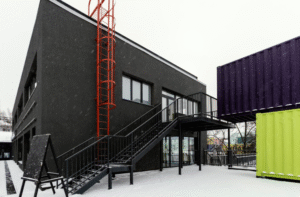
Historical Context of Double Story Container Architecture
Container architecture, including double-story homes, has roots in the global rise of modular construction. The concept emerged in the late 20th century when architects began experimenting with shipping containers as building blocks, inspired by their durability, availability, and standardized dimensions. The first notable residential projects appeared in the 1980s, with pioneers like architect Peter DeMaria designing container homes in the United States. By the 2000s, container architecture gained traction globally, driven by the need for affordable, sustainable housing in urbanizing regions.
In the UAE, container architecture aligns with the country’s history of embracing innovation, from traditional wind towers to modern skyscrapers. The region’s maritime heritage, as a hub for global trade, makes shipping containers a culturally resonant material. Early uses in the UAE focused on temporary structures, such as worker accommodations or event spaces during expos, but the past decade has seen growing interest in permanent residential applications, particularly double-story homes. This shift reflects the UAE’s focus on sustainability, as seen in initiatives like the Dubai Sustainable City, which prioritizes eco-friendly construction.
The evolution of container homes in the UAE is tied to global trends, such as the rise of prefabricated construction and circular economy principles. Architects have adapted container designs to the region’s climate, incorporating insulation, ventilation, and shading to combat heat. Cultural influences, such as the need for private family spaces, have shaped layouts, with double-story designs offering separate levels for communal and private areas. Understanding this history provides context for the growing popularity of container homes, positioning them as a natural progression in the UAE’s architectural journey.
The UAE Market for Double Story Container Homes
The UAE’s housing market is a dynamic ecosystem driven by urbanization, population diversity, and a commitment to sustainable development. Double story container homes are gaining prominence as a response to these trends, offering an alternative to conventional housing in urban centers like Dubai, Abu Dhabi, and Sharjah, as well as rural areas. The country’s focus on smart cities, green building standards, and economic diversification creates a supportive environment for modular construction, positioning container homes as a solution to individual and societal needs.
Several factors fuel demand for container homes in the UAE. The diverse population, including Emiratis and expatriates, seeks housing that balances functionality, aesthetics, and affordability. Young professionals in urban areas favor compact, modern designs with smart technology, while families prioritize spacious layouts with cultural features like majlis areas. The UAE’s extreme climate—high temperatures, humidity, and occasional sandstorms—requires homes with robust insulation and energy-efficient systems, which container homes can provide through advanced materials like reflective coatings and double-glazed windows.
Government initiatives play a critical role, promoting sustainable construction through policies like the Estidama Pearl Rating System in Abu Dhabi and Dubai’s Green Building Regulations. Container homes, with their use of repurposed materials and minimal waste, align with these standards. The UAE’s vision for inclusive communities also supports container homes, as their scalability makes them suitable for affordable housing projects, worker accommodations, or community facilities. The market’s growth reflects a broader shift toward innovative, eco-conscious housing solutions that meet the UAE’s unique needs.

Design and Customization Options in Double Story Container
Double story container homes offer unmatched design flexibility, enabling architects and homeowners to create spaces that reflect personal style, cultural preferences, and functional requirements. Architectural styles range from sleek, modern designs with clean lines, glass facades, and minimalist interiors to industrial aesthetics that embrace the raw texture of corten steel. Traditional designs can incorporate Arabic-inspired elements, such as arched doorways, patterned screens, or mosaic tiles, to resonate with UAE culture.
Customization options are extensive, allowing for tailored layouts. A typical double-story home might use 4-8 containers, configured in various ways: linear stacks for compact urban plots, staggered arrangements for visual interest, or L-shaped designs for larger sites. Interiors can include 2-5 bedrooms, multiple bathrooms, open-plan living areas, fully equipped kitchens with islands or built-in appliances, and specialized spaces like home offices, prayer rooms, or children’s play areas. Outdoor features, such as rooftop terraces, shaded courtyards, or pergolas, enhance livability in the UAE’s climate, providing spaces for relaxation or entertaining.
Structural modifications are central to customization. Containers are cut to create openings for windows, sliding glass doors, or skylights, with steel reinforcements ensuring integrity. Insulation, such as spray foam, rigid polyurethane panels, or mineral wool, is critical to combat heat transfer, while exterior cladding—wood, aluminum, stucco, or ceramic tiles—enhances aesthetics and weather resistance. Eco-friendly features, like solar panels, green roofs, or rainwater harvesting systems (despite low rainfall), align with the UAE’s sustainability goals. Smart home systems, including automated lighting, climate control, and security, add modern convenience.
Cultural considerations are vital. Homes can include private family spaces, such as a majlis for male guests or secluded areas for women, reflecting Emirati traditions. Accessibility features, like ramps or wider doorways, cater to elderly or disabled residents. Structural stability is ensured through steel beams, columns, or concrete foundations, designed to withstand wind loads and thermal expansion in the UAE’s climate. This blend of creativity, cultural sensitivity, and engineering makes double-story container homes a versatile option for diverse UAE residents.
Construction Process and Timeline for Double Story Container
Building a double story container home involves a multi-step process that leverages the prefabricated nature of shipping containers to streamline construction. The process begins with a comprehensive site assessment, evaluating soil conditions, drainage, accessibility, and proximity to utilities. In the UAE, sandy soils often require deep foundations, such as concrete piles, slabs, or piers, to support the weight of stacked containers. Geotechnical surveys confirm soil bearing capacity, ensuring stability for multi-level structures.
Containers are sourced from reputable suppliers, typically ISO-certified units previously used for shipping or brand-new models. Each container undergoes rigorous inspection for rust, dents, or chemical residues, ensuring compliance with safety standards. Modifications, often performed off-site, include cutting openings for windows, doors, skylights, or ventilation; welding reinforcements like steel beams or columns; and installing insulation to address the UAE’s high temperatures. Plumbing, electrical wiring, and HVAC systems are integrated, with cooling systems designed to handle peak summer loads.
On-site, containers are transported via flatbed trucks and lifted into place using cranes. Stacking requires precise alignment, with containers secured using bolts, welds, or interlocking systems. Engineers calculate load distribution to ensure stability, particularly for upper levels, which may support additional weight from furnishings, rooftop gardens, or solar panels. Foundations are poured with rebar reinforcement, anchoring the structure against wind or sandstorms. Interior finishing involves installing drywall, flooring (e.g., hardwood, tile, or vinyl), and fixtures like lighting, cabinetry, and appliances. Exterior finishes, such as marine-grade paint or cladding, protect against heat, humidity, and sand abrasion.
The entire process typically takes 3-6 months, depending on design complexity, compared to 12-18 months for traditional homes. Technologies like Building Information Modeling (BIM) create 3D models for accurate planning, reducing errors. Drones monitor progress, capturing aerial footage to ensure safety and quality. Augmented reality (AR) allows homeowners to visualize designs before construction. This efficient, tech-driven process results in a durable, functional home tailored to the UAE’s environmental and cultural context.
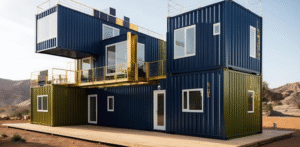
Safety and Structural Considerations
Safety and structural integrity are paramount in double story container homes, particularly in the UAE’s challenging climate. Corten steel containers are inherently durable, designed to withstand heavy loads and harsh marine environments, but stacking them requires careful engineering. Key considerations include load-bearing capacity, as upper containers exert significant weight on lower ones. Steel beams, columns, or cross-bracing reinforce stacking joints, ensuring stability.
Wind loads are a concern in the UAE, where gusts can accompany sandstorms. Aerodynamic designs, such as rounded edges or angled roofs, reduce wind resistance, while robust anchoring to concrete foundations prevents uplift. Thermal expansion, caused by temperature fluctuations, is addressed through flexible joints and materials that accommodate movement. Seismic activity, though minimal in the UAE, is considered in structural calculations to ensure compliance with international standards.
Fire safety is critical, as steel conducts heat, potentially intensifying fires. Flame-retardant insulation, fire-resistant drywall, and accessible exits are mandatory. Electrical systems must comply with International Electrotechnical Commission (IEC) standards, with circuit breakers and grounding to prevent hazards. In the UAE’s humid coastal areas, corrosion-resistant coatings and regular inspections prevent rust, particularly at welds or cut edges.
Accessibility is another focus, with designs incorporating ramps, wider doorways, or elevators for multi-level homes, ensuring inclusivity for elderly or disabled residents. Ventilation systems, such as cross-ventilation windows or mechanical air circulation, maintain indoor air quality in the UAE’s hot, dusty environment. By addressing these safety and structural considerations, double-story container homes offer a secure, reliable housing solution.
Costs and Investment Potential of Double Story Container
The cost of a double story container home varies based on factors like the number of containers, customization level, site conditions, and finishing materials. Basic designs with minimal modifications—using 4-6 containers and standard finishes like plywood flooring or basic insulation—are more affordable. Luxury designs, incorporating high-end materials (e.g., marble countertops, glass facades) and eco-friendly features (e.g., solar panels, smart systems), require greater investment. Additional costs include site preparation, foundation work, transportation, and permitting.
Compared to traditional homes, container homes offer significant savings due to their prefabricated nature, which reduces labor and material costs. Off-site modifications streamline construction, minimizing on-site expenses. For investors, double story container homes present opportunities in the UAE’s rental market, where demand for unique, sustainable properties is growing. These homes can serve as primary residences, vacation rentals, or commercial spaces like offices or cafes, offering versatile income streams.
Long-term savings come from energy efficiency, achieved through insulation, reflective coatings, and renewable energy systems, which reduce utility costs in the UAE’s hot climate. Maintenance costs are lower, as corten steel resists corrosion and requires minimal upkeep. Investors should consider location, intended use, and customization when evaluating potential, consulting financial advisors to explore financing options like loans or payment plans. The combination of upfront affordability and long-term returns makes double-story container homes an attractive investment.
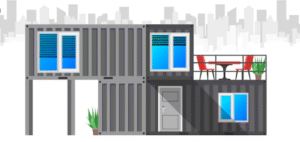
Regulations and Permits in the UAE
Building a double story container home in the UAE requires compliance with a complex regulatory framework, varying by emirate. In Dubai, the Dubai Municipality oversees approvals, while in Abu Dhabi, the Department of Municipalities and Transport sets standards. Container homes are often classified as temporary or modular structures, which can simplify permitting compared to permanent buildings, but they must meet stringent safety, structural, and environmental codes.
Fire safety regulations mandate flame-retardant materials, accessible exits, and fire suppression systems, particularly for multi-level homes. Thermal performance is critical, with codes requiring insulation to reduce heat gain, ensuring energy efficiency in the UAE’s climate. Electrical and plumbing systems must comply with international standards, such as IEC for electrical safety or UPC for plumbing. Accessibility requirements, like ramps or wider doorways, ensure inclusivity, especially for family-oriented designs.
The permitting process involves submitting detailed plans, including architectural drawings, structural calculations, and environmental impact assessments. Engineers must demonstrate that stacked containers can withstand wind loads, thermal expansion, and environmental stressors like sand abrasion. Environmental regulations align with the UAE’s sustainability goals, encouraging recycled materials and energy-efficient systems. Engaging licensed architects or consultants familiar with local codes streamlines approvals, ensuring compliance and avoiding delays. In rural areas, regulations may be less stringent, but urban projects require rigorous oversight, reflecting the UAE’s commitment to safe, sustainable construction.
Sustainability and Environmental Impact of Double Story Container
Double story container homes are a pinnacle of sustainable construction, repurposing shipping containers that would otherwise be discarded, reducing the demand for resource-intensive materials like concrete or brick. Each container reused diverts approximately 8,000 pounds of steel from landfills, contributing to a circular economy. In the UAE, where sustainability is a national priority, this aligns with initiatives like the UAE Vision 2021, which emphasizes environmental stewardship.
Energy efficiency is a key advantage. Advanced insulation materials—spray foam, rigid polyurethane panels, or mineral wool—minimize heat transfer, reducing reliance on air-conditioning in the UAE’s extreme heat. Reflective roof coatings and double-glazed windows further enhance thermal performance. Solar panels, leveraging the UAE’s abundant sunlight, can power lighting, appliances, and cooling systems, potentially achieving net-zero energy consumption. Battery storage systems store excess energy for nighttime use, enhancing efficiency.
Water conservation is critical in the UAE’s arid climate. While rainfall is minimal, greywater recycling systems reuse water from sinks or showers for irrigation or flushing. Green roofs or vertical gardens improve insulation, reduce urban heat, and support biodiversity, even in desert environments. Compared to traditional homes, container homes produce less construction waste, as modifications are primarily subtractive (e.g., cutting openings). Their modular design allows for disassembly and relocation, minimizing the environmental impact of future moves.
Smart home technologies, such as IoT-connected energy monitors, optimize resource use, tracking consumption in real time. By combining these features, double-story container homes support the UAE’s low-carbon agenda and commitment to sustainable urban development, offering a model for eco-conscious living.
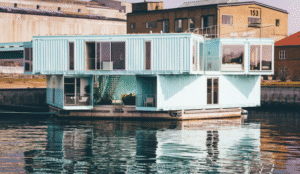
Challenges and Solutions
Double story container homes face several challenges in the UAE, but innovative solutions ensure their viability. Thermal regulation is a primary concern, as steel conducts heat, potentially making interiors uncomfortable. Solutions include high-performance insulation, reflective coatings, and strategic ventilation, such as cross-ventilation windows, mechanical air systems, or shaded overhangs designed for the UAE’s climate. Evaporative cooling systems can supplement air-conditioning, reducing energy use.
Public perception poses another challenge, as some view container homes as temporary or low-quality. Educational campaigns, showcasing their durability, customization, and successful projects, can shift attitudes. Virtual tours, open houses, or media coverage highlighting aesthetic and functional benefits build acceptance. Space constraints in urban areas are addressed by the compact, vertical design of double story homes, which maximize land use.
Logistical challenges, such as sourcing high-quality containers or coordinating transportation, require partnerships with reliable suppliers and logistics experts. Containers must be inspected for structural integrity, with certifications like ISO or CSC ensuring quality. Stacking containers demands skilled engineering, using steel reinforcements and precise alignment to ensure stability. Permitting hurdles can be navigated by working with experienced architects familiar with local codes. By addressing these challenges proactively, double-story container homes can thrive as a mainstream housing option.
Cultural and Lifestyle Fit in the UAE
Double story container homes align seamlessly with the UAE’s cultural and lifestyle needs, offering flexibility for Emirati and expatriate residents. Emirati culture emphasizes family, privacy, and hospitality, which container homes accommodate through designs like separate entrances, private majlis areas for male guests, or secluded family spaces for women and children. Multi-generational households benefit from layouts with multiple bedrooms, communal areas, and private retreats, fostering togetherness.
In urban centers like Dubai, container homes appeal to young professionals seeking modern, compact dwellings with smart technology and minimalist aesthetics. Features like home offices, rooftop terraces, or integrated IoT systems cater to fast-paced, tech-savvy lifestyles. In suburban or rural areas, larger designs with courtyards, shaded patios, or outdoor kitchens reflect the UAE’s love for blending indoor and outdoor living, especially during cooler months.
Cultural customization is a key advantage. Homes can incorporate Arabic-inspired elements, such as patterned screens, arched doorways, or prayer rooms, to resonate with local traditions. Accessibility features, like ramps or wider doorways, ensure inclusivity for elderly or disabled residents. The UAE’s emphasis on luxury is addressed through high-end finishes, such as marble flooring or custom lighting, while eco-friendly features align with the country’s sustainability ethos. By balancing cultural sensitivity with modern functionality, double-story container homes offer a versatile, culturally resonant housing solution.

Technology Integration in Double Story Container Homes
Technology enhances the functionality, comfort, and sustainability of double story container homes in the UAE. Smart home systems, integrated during construction, include automated lighting, climate control, and security features like cameras, smart locks, or facial recognition. In the UAE, where cooling is a major expense, smart thermostats optimize air-conditioning, reducing energy use while maintaining comfort. Motion sensors and voice-activated controls, compatible with platforms like Amazon Alexa or Google Home, add convenience.
The Internet of Things (IoT) enables real-time monitoring of energy, water, and system performance via mobile apps. For example, IoT-connected solar panels track energy production, while smart meters monitor consumption, helping homeowners optimize efficiency. Security systems with remote access enhance safety, particularly in urban settings. These technologies align with the UAE’s digital transformation goals, as seen in its smart city initiatives like Dubai’s Smart City Project.
During construction, advanced tools like Building Information Modeling (BIM) create 3D models for precise planning, reducing errors and costs. Augmented reality (AR) allows homeowners to visualize designs before construction, ensuring alignment with their vision. Drones monitor progress, capturing aerial footage to ensure quality and safety. By integrating these technologies, double-story container homes become cutting-edge residences that meet the UAE’s demand for innovation and efficiency.
Financing and Incentives
Financing a double story container home in the UAE involves exploring options tailored to modular construction. Banks offer loans for prefabricated homes, often with flexible terms due to their lower construction costs compared to traditional buildings. Some developers provide in-house financing or installment plans, making container homes accessible to a wider audience. Government incentives for sustainable construction, such as grants or tax breaks for eco-friendly projects, may apply to homes with features like solar panels, green roofs, or water-saving systems.
For investors, container homes offer opportunities in the UAE’s competitive rental market, where unique, sustainable properties attract tenants. These homes can serve as primary residences, vacation rentals, or commercial spaces, providing diverse income streams. The UAE’s investor-friendly policies, including long-term residency programs tied to property ownership, enhance the appeal of container homes. Buyers should consult financial advisors to evaluate loan options, repayment schedules, and eligibility for incentives, ensuring alignment with their financial goals.
Key considerations include assessing the total cost of ownership, including construction, maintenance, and utilities. Energy-efficient designs reduce long-term expenses, making container homes a cost-effective investment. By exploring financing options and leveraging incentives, buyers can make informed decisions, maximizing the value of their container home investment.
Maintenance and Durability of Double Story Container
Double story container homes use corten steel for durability, resisting corrosion and withstanding the UAE’s harsh climate of heat, humidity, and sandstorms. Builders apply marine-grade paint and sealants to protect the exteriors, and regular inspections keep the structures strong. Compared to traditional homes, these homes require minimal maintenance. Owners repaint every 5–10 years, check insulation for wear, and clean HVAC systems to maintain efficiency.
Interior maintenance involves standard tasks, such as servicing plumbing and electrical systems or cleaning flooring (e.g., hardwood, tile, or vinyl). Eco-friendly features, like solar panels or green roofs, require periodic checks, such as cleaning panels or maintaining irrigation systems. Structural components, particularly stacking joints and foundations, should be inspected annually to detect stress or corrosion, especially in coastal areas with high salinity.
In the UAE, where sand accumulation can affect exteriors, regular cleaning prevents buildup. Homeowners should schedule professional inspections to assess welds, bolts, and reinforcements, ensuring long-term stability. With proper care, container homes can last 50 years or more, offering a durable, low-maintenance housing solution that withstands the region’s environmental challenges.
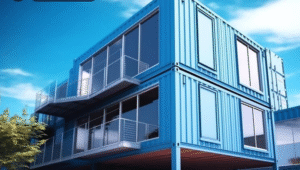
Community and Social Impact
Double story container homes contribute significantly to community development in the UAE by addressing housing shortages and promoting sustainable living. In urban areas, they offer affordable housing for young professionals, low-income families, or expatriates, reducing pressure on traditional markets. Community projects, such as schools, clinics, or worker accommodations, benefit from the rapid construction and cost-effectiveness of container homes, enabling quick deployment for social needs.
Socially, these homes challenge traditional housing norms, fostering innovation and inclusivity. Community engagement, through workshops, open houses, or media campaigns, can overcome skepticism about container homes’ quality or permanence. By incorporating cultural elements, like family-oriented layouts or prayer rooms, these homes resonate with UAE residents, strengthening community ties. Their eco-friendly design aligns with the UAE’s sustainability goals, promoting greener communities.
The scalability of container homes supports large-scale initiatives, such as housing for migrant workers or temporary shelters during events like Expo. By addressing housing needs and fostering social acceptance, double-story container homes contribute to the UAE’s vision for inclusive, sustainable urban development.
Aesthetic Integration with UAE Landscapes
Double story container homes can be designed to integrate seamlessly with the UAE’s diverse landscapes, from urban skylines to desert vistas. In cities like Dubai, modern designs with glass facades, clean lines, and reflective coatings complement the sleek architecture of skyscrapers. Industrial aesthetics, highlighting the raw texture of corten steel, add a unique contrast to urban settings, appealing to trendsetters.
In rural or desert areas, homes can incorporate earthy tones, such as sand-colored cladding or stone finishes, to blend with the natural environment. Shaded courtyards, pergolas, or green roofs create oases that reflect the UAE’s tradition of outdoor living. Coastal regions benefit from corrosion-resistant coatings and elevated foundations to protect against salinity and flooding. Cultural elements, like Arabic-patterned screens or arched windows, enhance aesthetic harmony with local traditions.
Lighting plays a key role, with exterior LEDs highlighting container textures at night, creating a striking effect. Landscaping, using native plants like date palms or drought-resistant shrubs, integrates homes with their surroundings while supporting sustainability. By tailoring designs to the UAE’s urban, desert, and coastal landscapes, double-story container homes achieve both aesthetic and functional harmony.
Export and Global Potential
The UAE’s strategic location, advanced logistics, and manufacturing capabilities position it as a potential hub for container home solutions, both domestically and globally. The country’s expertise in producing high-quality, ISO-certified containers enables the creation of durable, adaptable units for residential use. While the domestic market grows, there is potential to export container home designs to regions like the GCC, Africa, and Asia, where demand for affordable, sustainable housing is rising.
Globally, container homes are gaining popularity in areas facing housing shortages, natural disasters, or environmental challenges. The UAE’s experience with modular construction, combined with its focus on sustainability, gives it a competitive edge. Standardized yet customizable designs can be tailored to different climates and cultures, from desert environments to tropical regions. By investing in research and development, the UAE could lead the global container home market, promoting innovation and eco-friendly living worldwide.
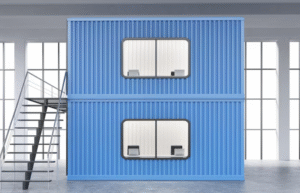
Future Trends and Innovations
The future of double story container homes in the UAE is shaped by technological advancements and societal shifts. Innovations like 3D printing could streamline container modifications, creating custom components like walls or fittings with precision and efficiency. Advanced materials, such as lightweight composites, graphene-based coatings, or enhanced insulation, improve thermal performance and durability, addressing the UAE’s climate challenges.
Modular scalability is a key trend, allowing homes to expand or contract as needs change, such as adding containers for growing families or downsizing for empty nesters. The UAE’s smart city initiatives drive demand for tech-integrated homes, with IoT systems enabling energy and water monitoring. Net-zero designs, combining solar power, green roofs, and energy-efficient appliances, align with the country’s environmental goals.
Consumer preferences are shifting toward sustainable, flexible housing, increasing demand for container homes. Public-private partnerships could accelerate adoption, with governments supporting pilot projects or incentives for modular construction. As these trends converge, double-story container homes are poised to become a mainstream housing option, transforming the UAE’s residential landscape.
Comparison with Other Modular Housing Types
Double story container homes are one of several modular housing options in the UAE, each with distinct advantages. Prefabricated homes, built from factory-made panels, offer similar speed and cost benefits but may lack the unique aesthetic of containers. 3D-printed homes allow for complex, bespoke designs but require significant investment in technology and materials. Tiny homes, while compact, are less suited for families or multi-level needs.
Container homes excel in durability, thanks to their corten steel construction, and sustainability, due to repurposed materials. They offer greater portability than prefabricated homes, as containers can be relocated with minimal disassembly. Compared to 3D-printed homes, container homes are more accessible, requiring less specialized equipment. In the UAE, where space efficiency and environmental impact are priorities, double-story container homes provide a balanced solution, combining affordability, functionality, and eco-friendly design.
Global Comparisons of Container Homes
Double story container homes in the UAE can be compared to global examples to highlight their unique adaptations. In Europe, container homes are popular for affordable urban housing, often using minimalist designs with extensive insulation to combat cold climates. But UAE designs prioritize heat resistance, with reflective coatings and robust cooling systems.
At the United States, container homes are common in rural or suburban areas, with larger layouts and fewer space constraints than in the UAE’s urban centers. On Asia, particularly Japan, container homes are used for disaster relief, emphasizing rapid deployment and portability. The UAE’s focus on luxury and cultural customization sets its container homes apart, with designs incorporating Arabic-inspired elements and smart technology.
Global trends, such as net-zero designs and modular scalability, are mirrored in the UAE, but the country’s extreme climate and sustainability goals drive unique innovations. By learning from global examples, the UAE can refine its approach, positioning itself as a leader in container home architecture.
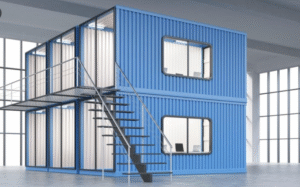
Buyer’s Guide: Choosing a Container Home Provider
Selecting a provider for a double story container home requires careful evaluation. Key criteria include experience with modular construction, ability to customize designs, and knowledge of UAE regulations. Buyers should review portfolios of past projects to assess quality, style, and alignment with their vision. Asking about construction timelines, material sourcing, and after-sales support ensures transparency.
Providers should use high-quality, ISO-certified containers and employ licensed architects or engineers to ensure structural integrity. Buyers should inquire about customization options, such as eco-friendly features or cultural elements, and request detailed contracts outlining scope, timelines, and responsibilities. Visiting completed projects or speaking with past clients provides insight into reliability and customer satisfaction. By prioritizing these factors, buyers can partner with a provider that delivers a high-quality, tailored container home.
Environmental and Social Certifications
Double story container homes can pursue environmental and social certifications to enhance credibility and align with the UAE’s sustainability goals. Certifications like the Estidama Pearl Rating System evaluate energy efficiency, water conservation, and material use, rewarding homes with features like solar panels, greywater recycling, or green roofs. LEED certification, though less common in the UAE, is another option, recognizing eco-friendly construction practices.
Social certifications, such as those for inclusive design, ensure homes meet accessibility standards for elderly or disabled residents. Certifications for community projects, like worker housing, highlight social impact, promoting fair labor practices and quality living conditions. Achieving these certifications requires collaboration with certified assessors and adherence to strict criteria, but they enhance the home’s reputation and appeal.
In the UAE, certifications align with national initiatives like the UAE Green Agenda 2030, boosting public acceptance and supporting regulatory approvals. Homeowners and developers should explore these options to maximize the environmental and social value of their container homes.
Conclusion
Double story container homes represent a transformative approach to housing in the UAE, offering sustainability, innovation, and cultural relevance. Their modular design, eco-friendly potential, and adaptability make them ideal for urban and rural settings, addressing the diverse needs of residents. From rapid construction to energy efficiency, cultural customization, and community impact, these homes align with the UAE’s vision for sustainable, inclusive urban development.
Whether you’re a homeowner seeking a unique residence, an architect exploring modular design, an investor pursuing innovative opportunities, or a policymaker promoting sustainable housing, double story container homes offer endless possibilities. Their ability to integrate with the UAE’s landscapes, cultures, and technologies positions them as a model for the future of residential architecture. Explore this housing solution by researching design options, consulting with experienced builders, and engaging with the growing community of container home enthusiasts in the UAE. Take the first step toward a sustainable, modern home today.
FAQs and Common Misconceptions
Are double-story container homes legal in the UAE?
Yes, they are legal when compliant with local building codes, often classified as modular or temporary structures, requiring permits from municipal authorities.
How durable are container homes in the UAE’s climate?
With proper insulation, coatings, and maintenance, they withstand heat, humidity, and sandstorms, lasting decades.
Are container homes only temporary?
No, they can be permanent residences with robust construction and high-quality finishes, comparable to traditional homes.
Do container homes feel cramped?
Double-story designs offer ample space, with customizable layouts for bedrooms, living areas, and outdoor spaces.
Are they eco-friendly?
Yes, repurposing containers reduces waste, and features like solar panels and insulation enhance sustainability.
Can they be customized for families?
Absolutely, with layouts including private family spaces, majlis areas, or multi-generational living areas.
Misconceptions include the belief that container homes are low-quality or unsuitable for families. In reality, they offer durability, customization, and comfort, making them a viable, long-term housing solution in the UAE.


